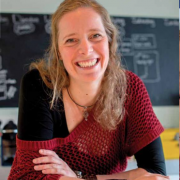In this session we will discuss the value of mobile devices for the exhibition context. We believe that “Bring your own device” is far from obsolete! The fear of infection through loan devices has risen sharply; fortunately, visitors have their own devices. We want to shed light on the associated possibilities and will share various approaches and examples. These range from additional content via an app or AR to innovations in which visitors control the exhibits themselves with their phone, or take the exhibition content and experiments out of the museum to their home, school or lab. Our discussion will look at mobile devices as constructive additions for the user - without losing sight of the actual experience. We will present new technologies and concepts that serve as good additional information or inspiration factors.
Exhibition and Programs
Wolfsburg
Germany
After phaeno gained experience with smartphone-controllable exhibits, phaeno has just launched an app to bring measurements with smartphone sensors and documentation of experiments to children from the age of 12. At phaeno, this app offers discovery tours through the exhibition gallery. For reasons of equal opportunities, we made a limited number of smartphones available for school classes. In this session I want to share our efforts, our experiences and my favorite experiments with smartphones.
Head of Education
Leiden
Netherlands
After our successful experiences with our program for teenagers on their own mobile devices in 2019, and a 360degrees tour during covid times we wanted to try using a VR game in the museum and made an app with and for primary schools. In this session I will share our ideas, our struggles and our solutions. Are we still enthusiastic using digital tools in museums or not?
Science Educator, Head of Explainer-School, Researcher
Munich
Germany
Use your smartphone as a mobile lab in the museum: This year we are trying to bringing it to the next level by putting external sensors in the exhibit – e.g. a suspension bridge. The visitors can collect and analyze the data with their smartphones. The idea of these exhibits is a multisensory experience for the visitor. We will share our experience – and the one of the visitors in this session.
Senior staff of Education & Public Engagement
Södertälje
Sweden
When hands-on went hands off, Tom Tits had to rethink their offer. We wanted to make our exhibition assessable to our visitors wherever they are located and extend a physical visit. We also have a challenge in how physical hands-on experience should meet digitalisation.
We came up with a solution that offers an additional layer by providing a digital interactive copy of a physical installation. During the development, we learned a lot about both our own exhibition, AR and the visitors.
exhibits &education
Bionicum in the Zoo
Nürnberg
Germany
Inspired by our special exhibition we have developed an app that presents bionic research in a playful way: How does bionic technology shape a greener future? The player finds out by doing a time travel to the year 2050. The goal is to gather energy for the return trip by solving tasks. Will the trip back work?
I would like to discuss the idea of an app outside of the museum: In what context will users use it? Do they use it? Well, actually I don’t know yet, but would like to share some experiences we gained so far.






